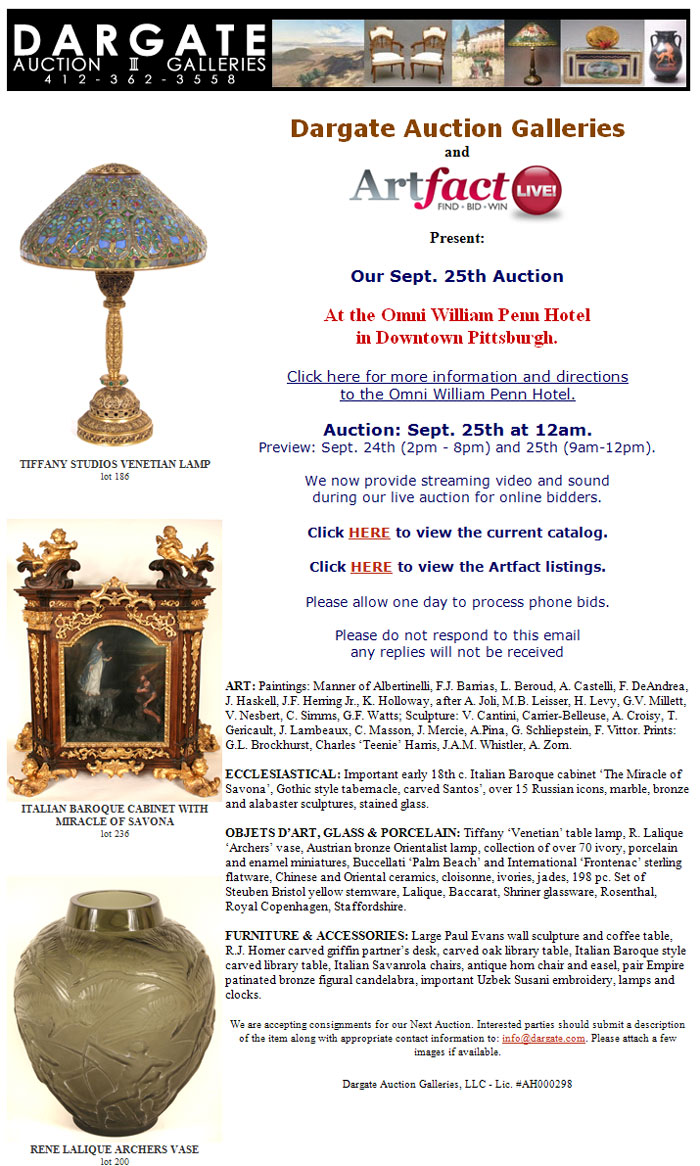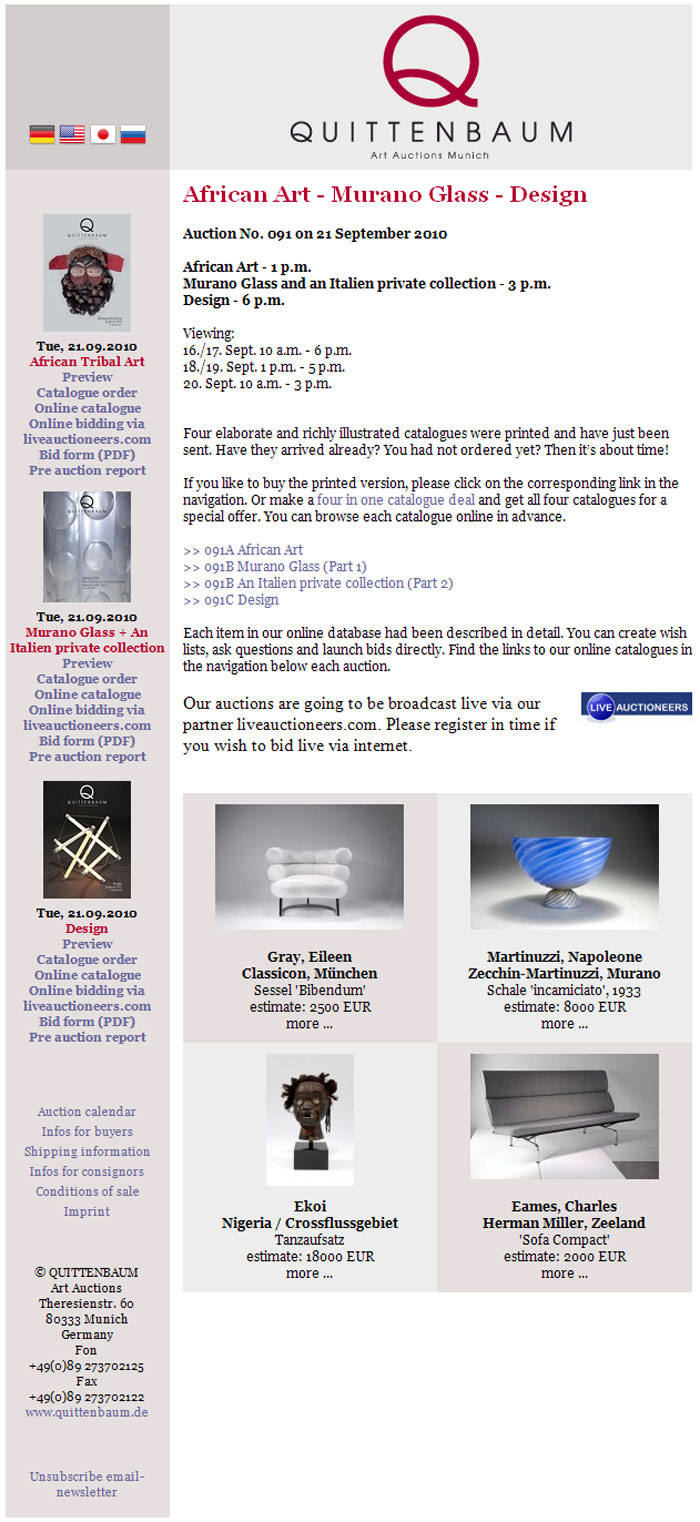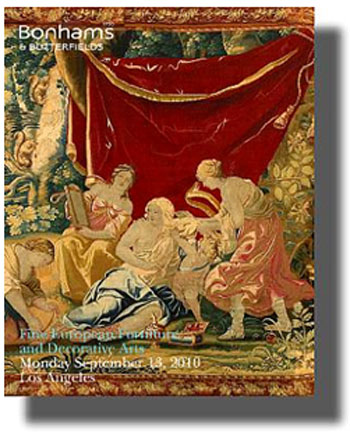Articles by admin
Picking with Reyne Vol 18 – The Finds are Still Out There
Tuesday, September 7th, 2010 I always love a good find, especially when it’s me doing the finding. Not the case for this story, but a good one none the less.
I always love a good find, especially when it’s me doing the finding. Not the case for this story, but a good one none the less.
Recently, the California auction house, Harvey Clars, reported the sale of a vintage trunk made by Fracois Goyard recently sold for $5,629. This was against a pre-sale estimate of $1,500 – $2,500.
Ok so that’s not so special. Seems these days more than ever auction houses and getting a premium for a vast array of things consigned to them.
The great part of the story was how the trunk was acquired.
The consignors bought the trunk years ago at a yard sale for $20. It was sold to them as just that; a charming old trunk – nothing more, nothing less.
It wasn’t until they were downsizing did they decide to sell it off and they chose Clars as the auction house to find a buyer.
The decorative arts specialist at Harvey Clars thought the trunk might be special, and quickly saw the period piece to be more than just nice luggage. The latches were signed Goyard Aine, Monte Carlo, Biarritz Paris. Also, the initials GNF, SF, No 4 were painted on the outside.
Francois Goyard was a luxury luggage maker in France at the turn of the century. The trunk also offered travel decals from places such as France, Italy and England.
The hammer price is a new record for a trunk of this style by Goyard.
Did I mention I acquired 2 Louis Vuitton trunks recently? Ok I didn’t – but a picker friend of mine did. A large trunk and a small makeup case. He sold them to me, and I was thrilled to acquire them. Truth be told, the large trunk weighs almost as much as I do, so I probably won’t keep it – but you can bet my makeup has never traveled in a fancier manner!
Happy Hunting!
Reyne
Reyne Gauge: Corvette Craze
Tuesday, September 7th, 2010 Anyone that knows me knows my love of Chevy Corvettes. I’ve had one as my daily driver for years and one day plan to add a ’63 Split Window (black on black of course) to my garage of toys.
Anyone that knows me knows my love of Chevy Corvettes. I’ve had one as my daily driver for years and one day plan to add a ’63 Split Window (black on black of course) to my garage of toys.
My passion for ‘vettes began as a kid. My mother drove a 1975 Corvette, bright blue with blue leather interior. My mom didn’t just drive a ‘vette, she knew plenty about them as well. Anytime we were out driving around, she’d test me on what year the Corvette was we’d pass in a parking lot or pulled up beside us. I knew the answer every time as she had taught me all the tell tale signs for what changes had been made each year. I also loved the camaraderie we had with other ‘vette owners. You always gave the “peace” sign to each other as you passed on the road. It was like some secret club that only we knew about.
We also belonged to the San Jacinto Corvette Club in Houston, Texas. They met monthly, and had car shows and race events periodically. I loved walking a parking lot filled with vettes. With a variety of models and paint jobs, I was in heaven. And who can resist the roar of a big block engine on the track? My mother used to drag race her ‘vette while I sat in the bleachers cheering wildly!
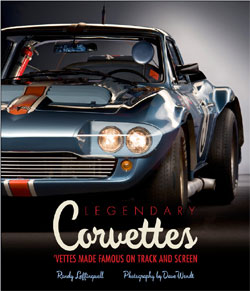 Perhaps that’s all a little TMI, but it’s how I became so crazed about anything Corvette related; including literature. Recently I caught wind of a new publication titled “Legendary Corvettes”: ‘Vettes Made Famous on Track and Screen. Just what I need, another book to tempt me into acquiring another car. (Ok so it’s not that hard to tempt me)
Perhaps that’s all a little TMI, but it’s how I became so crazed about anything Corvette related; including literature. Recently I caught wind of a new publication titled “Legendary Corvettes”: ‘Vettes Made Famous on Track and Screen. Just what I need, another book to tempt me into acquiring another car. (Ok so it’s not that hard to tempt me)
For starters, the book offers a cover that doubles as eye candy to peak the readers interest, and then opens into a poster, perfect for framing and hanging in the garage for motivation! Inside, the book covers 18 of the most prized Corvettes of all time; from the early models (and yes, there is a chapter on the ’63!) to the 2009 Blue Devil. I have yet to drive one of those – have you?
The book starts at the beginning and details how the Corvette came to life, other sports cars being produced at the time, and the people involved in bringing the Corvette to the production line. You get an understanding of what Chevy was up against in the racing world, and what they were willing to do to create a “Super Sports Car”.
Did you know they made a right side steering wheel Corvette? Ok, well not a production car. Did you ever catch the Mark Hamill movie “Corvette Summer”? Do you remember the Indy Pace car?
I could go on and on about what you’ll see if you buy this book, but I don’t want to give away all the highlights (and there are plenty!)
The book is written by Randy Leffingwell and photographed by the very talented Dave Wendt. It offers 175 pages of full color drool factor. This would make a great gift for that Corvette enthusiast in your life, or would impress your guests while sitting on your coffee table.
“Peace, Love & Corvettes”
Quittenbaum Art Auction Munich – African Art – Murino Glass – Design
Tuesday, September 7th, 2010Collecting West German Pottery: Thoughts, Philosophy, and History by Forrest D. Poston
Tuesday, September 7th, 2010The thought for the day in the Oprah newsletter for February 6, 2006 read, “Your home should replenish your senses and feed your soul.” Few companies or even eras offer as many ways to achieve that goal as does West German pottery. The forms and glazes on West German pottery are fascinating enough, but when you consider the soil from which such vitality and whimsy grew, the story takes on another dimension.
Work backwards through history and we have the economic struggles and political tensions of the 1970’s, the cold war of the 1960’s and 1950’s. We have WWII, the Nazi repressions, and for Germany and much of Europe, the slow recovery from WWI. That takes us to the time of the Bauhaus school, one of the most influential design schools of all time, an enduring, worldwide influence currently visible in Jonathan Adler’s designs.
The Bauhaus school represented modern, forward thinking, not exactly something the Nazi party favored. The pottery portion of the school closed in 1925, followed by the rest of the school in the early 30’s. Energy and resources were soon poured into the war, but the end result was psychological, emotional and physical rubble. Surely any art that could grow from such soil would echo Edvard Munch’s The Scream.
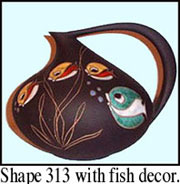 Instead, there came forms such as Ruscha’s shape 313 designed by Kurt Tschörner, elegance mixed with exaggeration, perfect proportions that please the eye and tickle the senses. Decorations ranged from cute mixed with innocence to geometric designs that somehow mixed a sense of challenge with a sense of humor. It certainly made marketing sense. Instead of Calgon, it was “Pottery, take me away.”
Instead, there came forms such as Ruscha’s shape 313 designed by Kurt Tschörner, elegance mixed with exaggeration, perfect proportions that please the eye and tickle the senses. Decorations ranged from cute mixed with innocence to geometric designs that somehow mixed a sense of challenge with a sense of humor. It certainly made marketing sense. Instead of Calgon, it was “Pottery, take me away.”
Through the 1950’s and into the early 60’s, the most popular designs echoed the Art Deco period, particularly the vitality of that era plus the insistent innocence that later infused “Happy Days”. However, unlike the angular, geometric forms of the Art Deco period, many of the early West German forms featured gentle curves, just not quite where you expected to find them. While some forms maintained a classic look, asymmetry gave others the look of caricature.
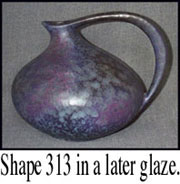 From around 1965 into the mid 70’s, forms and colors grew more exaggerated and more intense without losing that fine sense of proportion and whimsy. In a paradox typical of this pottery, soothing earthtone glazes were popular at the same time, sometimes on the same piece with a vibrant orange or other lively Pop Art shade. Lava glazes and other textural elements added another level of variety and complexity.
From around 1965 into the mid 70’s, forms and colors grew more exaggerated and more intense without losing that fine sense of proportion and whimsy. In a paradox typical of this pottery, soothing earthtone glazes were popular at the same time, sometimes on the same piece with a vibrant orange or other lively Pop Art shade. Lava glazes and other textural elements added another level of variety and complexity.
Beginning in the early 70’s, a weak economy began to take its toll, and factories closed. By the mid 70’s, it was clear that the special drive that grew out of repression was losing momentum, and one of the great eras in art pottery was coming to a close. But the more I’m around the better pieces, the more I believe that the spirit that enabled art and artists to survive was poured into the pottery, and the vitality went not only into a range of creativity possibly unmatched for breadth and depth but into the designs and clay.
This art became not only the result of vitality but about vitality, and that strength and energy come out in the pottery even now, radiating into the room. Even the sense of whimsy underlying so much of the art is about survival because without the perspective supplied by humor survival becomes about hardness, not hope.
Ways to Collect West German Pottery
Some collectors have stumbled into the W. German field by buying an item or two at the low-risk cost found at yard sales or thrift shops. Others have seen some sweet items available but can’t quite decide to take the chance. Quite often the question is, “where do I go from here?” What does it mean to collect West German pottery? That’s a big question for a novice in any collecting category, but it’s even bigger when the field is virtually untraveled with no well-worn paths to follow and no books acting as maps, not even a good idea of what the choices are.
The beginning point is the same in any collecting field: start according to your taste, budget, and experience. As with any good philosophy, the idea is simple and straightforward. It’s the application that’s hard. Budget is the easiest part for most of us, those who consider the term extra money an oxymoron. Still, just because we’re broke doesn’t mean we don’t need beauty around us.
Rule number one is buy the best you can afford. Sometimes that means buying one really good piece, sometimes buying two or three fairly good pieces. It also means don’t go wild and buy a bunch of poorly done pieces just for the sake of quantity. Even though the most widely available items are the tourist pieces, there are better and worse pieces even within that category.
For inexperienced collectors, there’s a sub-category of vases with gold glazes that makes a good entry point. Several companies did items with gold-highlighted glazes. In this case, that means gold glaze, not just gold that’s painted on. A gold glaze can be rather tricky, so there’s value in the difficulty as well as the appearance.
Most of the vases in this category are relatively small (3-6″) and often have fairly traditional, classic forms. Prices on these tend to be low, particularly compared to the aesthetic value, and even when W. German items become more widely known, many of the simple versions will stay within relatively easy economic reach. However, there are also nicer items within the category.
The potential value on the gold glazes is based on form, glaze complexity, and size. The odd, exaggerated forms represent the period and will generally be more prized by mid-century collectors. Glazes with more complex, usually abstract, patterns will also command a higher price. Collectors of American art pottery will find some items reminiscent of Weller Cloudburst.
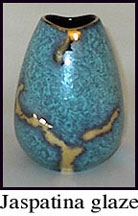 Collectors in this field can work up from fairly mass market items to the finer versions. Makers include Bay and Carstens, but the Jaspatina glaze from Jasba is among the best. Items over 8″ appear to be uncommon, and glazes combining red and gold among the most uncommon. Most of the gold-glazed work dates from 1956 to the early 1960’s.
Collectors in this field can work up from fairly mass market items to the finer versions. Makers include Bay and Carstens, but the Jaspatina glaze from Jasba is among the best. Items over 8″ appear to be uncommon, and glazes combining red and gold among the most uncommon. Most of the gold-glazed work dates from 1956 to the early 1960’s.
While much of the W. German work is unusual in form and decoration, collectors can often find connections with other fields to bring a sense of familiarity that may help collectors determine just where they’re tastes and preferences lie within the W. German field. For example, many W. German items have archaic decorations and coloring that fit well with a southwestern theme.
Even glass collectors will find connections, especially those who collect Blenko or Pilgrim. The strong colors and emphasis on large items will make those collectors feel right at home. Collecting through such comparisons also opens intriguing cross-collecting possibilities.
I’ve found that many collectors get a bit fixated on a particular item or style, but playing glass off of pottery or one style with another can create surprising combinations with a feeling all their own. I know one collector who puts her 1970’s Pop Art vases alongside her utilitarian crocks and is delighted with the result. Perhaps the idea just brings out the child in me, going back to happy hours spent combining blocks in every combination possible and mixing in other toys just to see what happened.
 Several companies also used a motif that I call a heartstripe, an irregular, horizontal band of contrasting color around the center of the vase. These stripes are most often found in orange or red, which suggests a vitality emanating from the center. In some cases, the stripe is bound top and bottom by a lava glaze that creates a geological look and opens numerous philosophical readings for those so inclined. Scheurich, Carstens, Steuler, and Hutschenreuther were particularly fond of this motif.
Several companies also used a motif that I call a heartstripe, an irregular, horizontal band of contrasting color around the center of the vase. These stripes are most often found in orange or red, which suggests a vitality emanating from the center. In some cases, the stripe is bound top and bottom by a lava glaze that creates a geological look and opens numerous philosophical readings for those so inclined. Scheurich, Carstens, Steuler, and Hutschenreuther were particularly fond of this motif.
It’s also possible to collect by shape or glaze. Many of the shapes were produced for a fairly long period and can be found in numerous glazes. Two particular examples are Ruscha shape 313 (designed by Kurt Tschörner) and Scheurich shape 271 (designed by Hans Siery). Both shapes are fairly easily found, but coming up with all the glazes could be a lifetime project. Ruscha 313 was produced for about 30 years and 50 or so different glazes.
Perhaps the only way I don’t suggest collecting is by name. In W. German pottery, it’s rather difficult anyway since both the company and the designer are so often still unknown. However, the real problem is that collecting by name has a tendency to run up the cost without relationship to any real value. At the moment, pieces attributed to Bodo Mans sell higher just because of the name, and the ironic part is that this name value comes from Mans’ connection to France and Picasso, an odd reason to buy German pottery.
Some of the Mans designs are certainly attractive, but others are much less so, and there’s serious doubt about some of the attributions. On the other hand, I’m personally fond of designs I’ve seen by Cari Zalloni, so there can certainly be connections between collector and designer. The trick is to always consider the piece, not just the name.
In some respects, collecting should be done much like child raising, with a mix of freedom and control. A good collection really is much like a living thing, growing in often unexpected ways and sometimes needing to leave some things behind. Fortunately, with a collection you can sell or give away the items that no longer please you as they once did, a method not generally approved of with children.
Still, you don’t have to worry about getting your collection “right”. You will change, and so will the collection and your relationship with it. Be willing to take some chances (within the limits of your budget) and buy a piece that speaks to you even though it doesn’t seem to fit right now.
Even with the pieces you have at home, think of them like the blocks you played with as a kid, moving them around, always trying new arrangements just to see how the relationships change. Try the soothing items in one room and the eye-poppers in another, then try mixing them. You may be able to create a sense of story depending on how items connect.
Most importantly, make sure that your collection makes you happy. You should enjoy walking into the room more because of the pottery. And be sure to slow down enough to let the pottery speak. Let yourself be soothed by that gentle curve or be revitalized by that orange heartstripe.
Antiquing in Buenos Aires by Bob Frassinetti
Thursday, September 2nd, 2010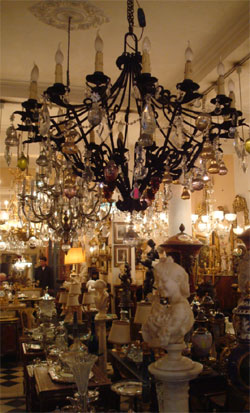 Rare and incredible objects, furniture, books, toys, artworks… all those antiques and collectibles you dream of can be found in Buenos Aires.
Rare and incredible objects, furniture, books, toys, artworks… all those antiques and collectibles you dream of can be found in Buenos Aires.
Once upon a time Buenos Aires was a very small port city with very little population surrounded by one of the world’s most fertile lands. Not too far away there were several other populations with very different traditions to the Spaniards who had populated this portside area. As the city grew and the Porteñan society evolved many Europeans chose Argentina to be their home. They immigrated with all their possessions from every corner of the old continent. This flow from Europe to Argentina first began in mid 19th century, and has never stopped till now. At the same time, as the world evolved –wars, economical possibilities, inspiration, were many of the causes that help other people chose our country as their own.
All of these new immigrants that were coming from Europe (Western and Eastern), Middle East, Asia and Africa, as well as many other Latin American countries, brought with them all kinds of objects, from paintings to mirrors and combs, from decorative items to all kinds of furniture, and so on.
This brief history of immigration in Argentina might help those that don’t know our country to understand a bit about the eclectic variety of items that can be found in this beautiful city that is Buenos Aires (specially Buenos Aires because it has always been the main gate to our great and beautiful country). Many of them were brought in immigration ships, many others were sent to these families from their homelands, some others were imported, and some other ones were the result of business among relatives who lived in their homelands and these new immigrants that were building a life in our Pampas. Those valuable family objects some times due to hard economic situations, or may be because there was no one to inherit them, have taken a path towards flea markets, auctions or antiques shops.
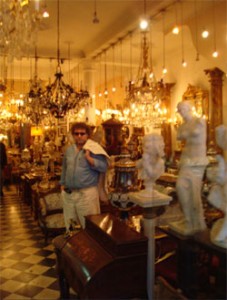 During the last few years there has been a huge turn in our economy, the peso (local currency) has lost much of its value in relation to the dollar and the Euro, this situation has impacted in many areas of our everyday life. On the dark side one of the biggest consequences of this economic shift has been an intense flow of goods towards all kinds of markets, in order to keep on with a certain lifestyle. Therefore many families have found themselves in a situation were they had to sell many of their family’s goods. On the bright side this new valuation of the peso has made of Argentina a more appealing place to visit for foreigners, since its much cheaper than many other big international metropolis though still shows all its splendor in its culture, art, fashion and good sense of living.
During the last few years there has been a huge turn in our economy, the peso (local currency) has lost much of its value in relation to the dollar and the Euro, this situation has impacted in many areas of our everyday life. On the dark side one of the biggest consequences of this economic shift has been an intense flow of goods towards all kinds of markets, in order to keep on with a certain lifestyle. Therefore many families have found themselves in a situation were they had to sell many of their family’s goods. On the bright side this new valuation of the peso has made of Argentina a more appealing place to visit for foreigners, since its much cheaper than many other big international metropolis though still shows all its splendor in its culture, art, fashion and good sense of living.
Our local flea markets, open fairs and antiques shops are open history books that show this turns in our lives.
Plus, these are excellent places to shop for those items all art lovers dream of, as well as an excellent opportunity for art dealers that wish to offer their regular clients high class items at reasonable prices.
One of the most beautiful open air markets in the city is in the historical neighborhood of San Telmo, that’s open all day during Sundays, from very early in the morning to late in the afternoon. Surrounded by countless antiques shops that open their doors to the public all week long, this fair is just beautiful, with very good quality items… Bargaining is always an interesting possibility when acquiring these type of objects, always a plus to get what you want at the price you want to.
In the outskirts of the city, the Solano fair is one outstanding market where if you have a sharp eye for antiques you can find absolutely amazing treasures. Since this fair is very much for locals you can find all from old clothes, semi used house goods, and whatever people had and needed to sell… Its always better to visit this outskirts out of the tourists path fair with a local, best if you know what you want but don’t have much time and your Spanish is not very good.
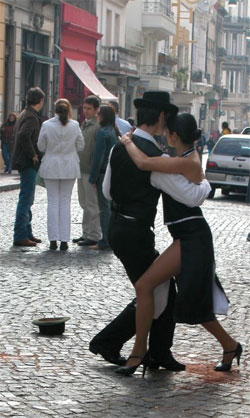 Back to the city, one excellent flea market is the Dorrego Market, in the heart of Palermo, very nearby a great restaurants area, this market has all kinds of items. Its just a matter of walking around and talking with the local people that are very kind and would gladly help you in your quest.
Back to the city, one excellent flea market is the Dorrego Market, in the heart of Palermo, very nearby a great restaurants area, this market has all kinds of items. Its just a matter of walking around and talking with the local people that are very kind and would gladly help you in your quest.
On the other end of the city, during the weekends there’s an other kind of flea market in Peru abajo. Located in the beautiful residential area of Acasusso you will find this fair has all kinds of decorative items and furniture, one of its specialties are chandeliers at very reasonable prices… High class and good prices, one excellent combo!
These are the most representative fairs and markets in BA. There’s nothing you can’t get, you name it, they have it… And of course, these are excellent sights when touring through the city of tango, ‘cause there are many different street shows that weekly chose those locations to show their art: tango, puppeteers, street theatre, live music, plus all kinds of local street food to enjoy during your walk, there’s no way that can go wrong!
Bob Fressinetti is a writer and antique enthusiast living in Buenos Aires
New Orleans Auction Gallery Two-Day Major Estates Auction
Wednesday, September 1st, 2010Gold and silver coins found in hidden suitcases attract strong bidding in Stephenson’s Aug. 20 auction
Wednesday, September 1st, 2010SOUTHAMPTON, Pa. – It was a story that might easily have been written for television – but in this instance, it was strictly nonfiction. While assessing her late father’s possessions prior to sending a consignment off to auction, a Philadelphia woman made a fortuitous discovery in the garage of the family home. There, amongst the garden tools and bric-a-brac, she came across several weighty suitcases that had long been stashed out of sight. Thinking they might contain old clothes or discarded household articles, the woman was taken completely by surprise when she opened the cases to find a horde of valuable old coins, many of them silver and gold.
“Nobody knew about the collection. Her father had never told anyone about it,” said Tom Wakeley, general manager of Stephenson’s, the company that auctioned the coins on Sept. 20 at their suburban Philadelphia gallery.
The collection ended up being “a tremendous success” at auction, Wakeley said, garnering $88,000 inclusive of 10% buyer’s premium.
“At this sale we had more live bidding than we did absentee and phone bidding because there were a number of nice pieces of gold in the collection. Buyers of gold coins like to inspect them and judge the condition for themselves,” Wakeley explained. Ninety-five percent of the 417 lots offered were purchased by in-house bidders.

Nineteenth-century gold coins of various denominations were offered in the sale, including an 1899 $10 gold piece (lower right), which sold for $660. Stephenson’s Auctions image.
Top-selling specimens included a 1907 $2.50 gold piece that realized $632.50 and an 1899 $10 gold piece that made $660.
A wealth of silver was available to bidders, as well. Seven Morgan half dollars from the early 20th century were sold as one lot for $1,430; while a book containing 27 silver commemorative half dollars from the mid-20th century finished its bidding run at $2,640 – quite an impressive result for coins whose total face value was a mere $13.50. Wakeley commented that condition was what drove the price on the grouping. “The half dollars were in uncirculated or even brilliant uncirculated condition, and that’s what collectors are looking for,” he said. “With money being so tight, collectors won’t spend a lot for average-condition coins, but if a coin is pristine, the money will come out.”
Other highlights of the Aug. 20 sale at Stephenson’s included an 1849 Seated Liberty silver dollar, $715; a book of 21 early 19th-century half cents, $1,017.50; and an exceptionally nice, unopened proof set containing each U.S. coin minted in 1950, which sold for $660.

A grouping of Barber dimes from the late 19th century/early 20th centuries sold as one lot for $1,210. Stephenson’s Auctions image.
Wakeley commented that, compared to buyers of other types of antiques, collectors who purchase coins at auction will cut to the chase. “At some auctions, bidders will hold out in hopes that the auctioneer will open a lot at a lower price, but at a coin auction, if the auctioneer asks for $25 and the coin is worth $500, they’ll just yell it out,” Wakeley said. “They already have the value figured out according to the price of silver or gold. That helps the auction go a little more quickly, too.”
Stephenson’s will conduct its next coin auction on Oct. 1, 2010, and will offer part II of the same collection featured in the Aug. 20 sale. For additional information, call Stephenson’s Auctioneers at 215-322-6182 or e-mail info@stephensonsauction.com. Visit Stephenson’s online at www.stephensonsauction.com.
Antiques in Philadelphia
Tuesday, August 31st, 2010With its cobblestone side streets, preserved buildings and revolutionary monuments on almost every corner, Philadelphia is certainly a historical treasure. And like any beautiful old city, Philadelphia is prime hunting ground for beautiful collections of old things, especially if one knows where to look.
If you’re antiquing in Philadelphia, head first to Chestnut Hill, just to the north of center city. Germantown Ave, marked by streetcar tracks, runs down the middle of this quiet leafy neighborhood lined with the awnings of bakeries, toy stores, and a locally famous cheese shop. This is a place where bells jingle when you push open shop doors that have clearly stood on their thresholds for generations, if not centuries.
The entire neighborhood speaks to the best of authentic high-end shabby chic—Even private homes blocks from Germantown Ave display a mesmerizing combination of age and Philadelphia grace, with elegantly peeling Victorian window frames and vine-tangled garden gates. Try to open an antiques shop here and you’d better be able to keep up with customers who know exactly what they’re looking for and can afford it when they see it.
Strolling westward from Abington Ave, stop first in Lavender Hill, owned by Florence Maloumian. Simple and lovely paintings from the rural Catskills, refinished Eastlake Victorian furniture, and the signature pieces in the store—collections of dried and silk flowers in playful color combinations– draw the eye to every corner of Lavender Hills’ artistically cluttered space.
Next stop in at Garden Gate Antiques, a multi-owner shop a few doors down. Make a note of the authentic African pieces in the back corner, including statuary from Malawi and a curious Sowei mask “for women’s initiation.” Run by a husband and wife team of passionate African art collectors, this section of the store features masks and textiles at marked down prices for the rest of the summer.
Move next to George Hoby’s shop where a wall-mounted bighorn sheep gazes out over a collection of odds and their corresponding ends arranged in layers so dense you’ll want to slow your gander so as not to miss anything. Hoby himself presides from the back of the store in a chair that I spent some time studying (not for sale apparently, though I doubt I could afford it if it was). The space is a bit too small for an extensive furniture collection, but features watercolors by Abraham Hankins, ceramics, and everything from old flutes, to girly art-deco ads, to salt and pepper shakers. Hoby’s easy style makes the room a pleasant place to linger for a while.
And finally, no antiquing day in Chestnut Hill is complete without a look into the Antiques Gallery. This shop is representative of the neighborhood in many ways, but it’s best to know your own preferences here, since there’s a lot to see and the store sometimes keeps non-standard hours.
While strolling and perusing, examine the unbelievable collection of maps and historic prints at the map store. Take a break for coffee at Cake or the bakery across from the toy store, and don’t miss the cheese shop. Years ago, the owners of this place offered me a taste of Papillion French blue cheese that changed my life. Chestnut Hill tends to make an afternoon of antiques shopping into a complete experience– Take advantage of the tendency, especially if you’re only in town for a day or two.
By Erin Sweeney
for Antiques.com

